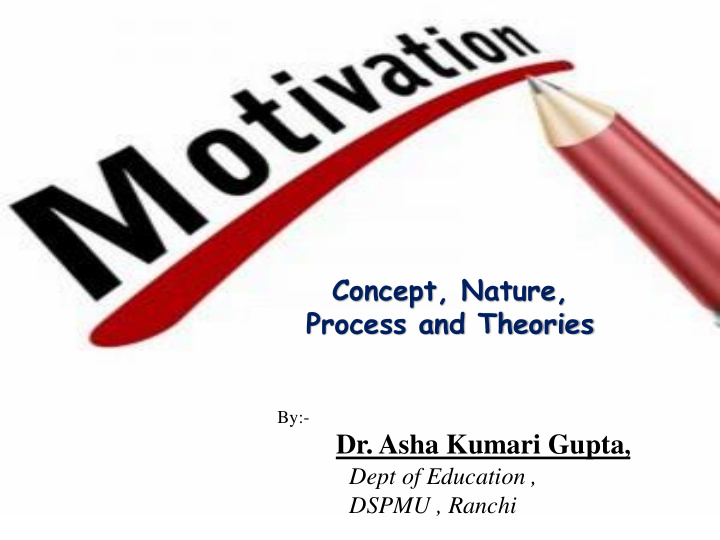



Concept, Nature, Process and Theories By:- Dr. Asha Kumari Gupta , Dept of Education , DSPMU , Ranchi
Motivation Latin Word Movere To Move Definition : Motivation can be defined as an inner state that activates, energizes or moves behaviour towards goal.
Motivation As the process that accounts for an individual’s intensity , direction and persistence of effort toward attaining a goal. Soichiro Honda Success story Inspiring career story of Henri Ford
What Is Motivation? Direction Intensity Persistence
Motivation • Intensity : how hard a person tries. • Direction: intensity needs to be channeled in a direction favorable to the organization for job satisfaction.. • Persistence : a measure of how long a person can maintain his or her effort … Motivated individuals stay with a task long enough to achieve their goals.
Motivation: nature & importance • Nature • One motive may result in many different behaviors • Motives are the energizing forces within us • The same behavior may result from many different motives • Motives may operate in harmony or in conflict • Motives come and go • Motives interact with environment
Motivation: nature & importance Importance Performance = Ability x Motivation • Puts human resources into action • Improves level of efficiency of employees • Leads to achievement of organizational goals • Leads to stability of work force
Motivation Process It is a series prompts the Motives of activities people to creates a under taken. action, it state of Behavior activates the imbalance. directed to thrust towards Attaining goal attain goal reaching a goal restores it Motive Behavior Goal Tension Reduction
A Job Performance Model of Motivation Individual Inputs Ability, Job knowledge Skills temperament & Traits Emotions, Moods, &Affect Motivational Beliefs & Values Processes Arousal Attention Intensity Motivated & & Behaviors Direction Persistence Job Context Physical Environment Task Design Rewards & Reinforcement Enable, Limit Supervisory Support & Coaching Social Norms Organizational Culture
A Job Performance Model of Motivation (cont.) Individual Skills Motivated Behaviors Inputs Focus: Direction, What we do Intensity: Effort, how hard Motivational we try Performance Processes Quality: Task strategies, the way we do it Duration : Persistence, how long we stick to it Job Enable, Limit Context
Model of Motivation Mobilization Incentive Tension Drives Unsatisfied Need of Behaviour Drive Reduction Satisfaction
Theories of Motivation Theories of Motivation What Content Theory Process Theory How Motivates motivates Maslow’s Theory Vroom’s Expectancy Theory Herzberg Two Factor Theory Adam’s Equity Theory Alderfer’s ERG Theory Goal- Setting Theory
Theories of Motivation: Content Theories Content theories: Focus on factors within the person that • energize, direct, sustain, and stop behavior. They attempt to determine the specific needs that motivate people (individual needs for job satisfaction, behavior, and reward systems). Aware of differences in people.
Theories of Motivation: Content Theories Maslow’s Need Hierarchy Abraham Maslow hypothesized that within each human being , there exists a hierarchy of five needs – Physiological – hunger, thirst, shelter and • all bodily needs. Safety – security & protection from • physical & emotional harm Social – affection, belongingness, • acceptance, friendship. Esteem – internal esteem includes self- • respect, autonomy & achievement. External esteem – status, recognition & attention. Self-actualization – drive to become • what one is capable of becoming includes growth, achieving one’s potential & self- fulfillment.
The theory states that although no need is ever fully gratified, a substantially satisfied need no longer motivates. According to Maslow, if you want to motivate someone, you need to understand what level of the hierarchy that person is currently on and focus on satisfying those needs at or above that level.
Theories of Motivation: Content Theories Herzberg Two Factor Theory Frederick Herzberg with the • belief that an individual's relation to work is basic & that one’s attitude toward work can very well determine success or failure proposed this theory. According to him certain • characteristics tend to be consistently related to job satisfaction & others to job dissatisfaction. Intrinsic factors such as work • itself, responsibility & achievement seem to be related to job satisfaction. Extrinsic factors such as • supervision, pay, company policies & working conditions lead to job dissatisfaction.
Theories of Motivation: Content Theories Alderfer ERG Theory Alderfer after reworking on Maslow’s • theory argued that the are three groups of core needs – existence, relatedness & growth. Existence – concerned with providing • our basic material requirements. They include the items of physiological and safety needs. Relatedness – the desire for • maintaining important interpersonal relationship. Thus includes the social need. Growth – an intrinsic desire for • personal development. This includes both self esteem and self actualization needs.
Relationship of all content theory of Motivation ERG Two Factor Need Theory Theory Hierarchy Self Actualization Growth Motivation Esteem Relatedness Belongingness Security Hygiene Existence Physiological
Recommend
More recommend